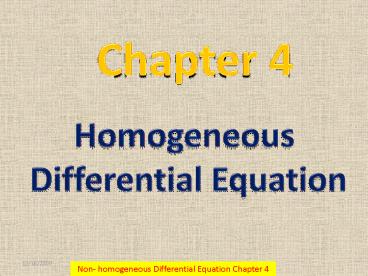Homogeneous - PowerPoint PPT Presentation
1 / 19
Title:
Homogeneous
Description:
The fact that all these functions are solutions can be verified by a direct calculation. ... A finite sum, product of two or more functions of type (1- 4) ... – PowerPoint PPT presentation
Number of Views:126
Avg rating:3.0/5.0
Title: Homogeneous
1
Chapter 4
Homogeneous Differential Equation
2
Second Order Differential Equations
A differential equation of
the type aybycy0,
a,b,c real numbers,is a homogeneous linear
second order differential equation.
Definition
Homogeneous linear second order differential
equations can always be solved by certain
substitutions.
To solve the equation aybycy0 substitute y
emx and try to determine m so that this
substitution is a solution to the differential
equation.
Compute as follows
The equation am2 bm c 0 is the
Characteristic Equation of the differential
equation ay by cy 0.
Definition
3
Solving Homogeneous 2nd Order Linear Equations
Case I
Equation
aybycy0
CE
am2bmc0
Case I
CE has two different real solutions m1 and m2.
In this case the functions y em1x and y em2x
are both solutions to the original equation.
General Solution
The fact that all these functions are solutions
can be verified by a direct calculation.
Example
CE
General Solution
4
Solving Homogeneous 2nd Order Linear Equations
Case II
Equation
aybycy0
CE
am2bmc0
Case II
CE has real double root m.
In this case the functions y emx and y xemx
are both solutions to the original equation.
General Solution
Example
CE
General Solution
5
Solving Homogeneous 2nd Order Linear Equations
Case III
Equation
aybycy0
CE
am2bmc0
Case III
General Solution
Example
CE
General Solution
6
Real and Unequal Roots
- If roots of characteristic polynomial P(m) are
real and unequal, then there are n distinct
solutions of the differential equation - If these functions are linearly independent, then
general solution of differential equation is - The Wronskian can be used to determine linear
independence of solutions.
7
Example 1 Distinct Real Roots (1 of 3)
- Solve the differential equation
- Assuming exponential soln leads to characteristic
equation - Thus the general solution is
8
Complex Roots
- If the characteristic polynomial P(r) has complex
roots, then they must occur in conjugate pairs, - Note that not all the roots need be complex.
General Solution
9
Example 2 Complex Roots
- Consider the equation
- Then
- Now
- Thus the general solution is
10
Example 3 Complex Roots (1 of 2)
- Consider the initial value problem
- Then
- The roots are 1, -1, i, -i. Thus the general
solution is - Using the initial conditions, we obtain
- The graph of solution is given on right.
11
Repeated Roots
- Suppose a root m of characteristic polynomial
P(r) is a repeated root with multiplicity n.
Then linearly independent solutions corresponding
to this repeated root have the form
12
Example 4 Repeated Roots
- Consider the equation
- Then
- The roots are 2i, 2i, -2i, -2i. Thus the general
solution is
13
Non Homogeneous Differential Equation
- The general solution of the non homogeneous
differential equation - There are two parts of the solution
- 1. solution of the homogeneous part of
DE - 2. particular solution
14
- General solution
Particular Solution
Complementary Function, solution of Homgeneous
part
15
Method of undetermined Coefficients
- The method can be applied for the non
homogeneous differential equations , if the f(x)
is of the form - A constant C
- A polynomial function
- A finite sum, product of two or more functions of
type (1- 4)
16
(No Transcript)
17
(No Transcript)
18
(No Transcript)
19
(No Transcript)

